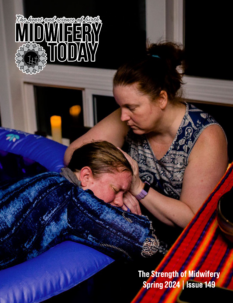
The Homebirth Choice
Editor’s note: This article first appeared in Midwifery Today, 1992.
Subscribe to Midwifery Today Magazine
Updated September 2008
Contents
- Why Homebirth?
- Considerations
- Practitioners
- Midwifery
- Prenatals
- Labor
- Complications
- Birth
- Resources
This document discusses homebirth as one of many avenues toward a successful birth—one that results in a happy and healthy mom and baby. We offer this in support of education, freedom of choice and empowerment of women and their families. While aimed at parents, those considering the profession of midwifery will also find it a useful overview of what a midwife does. It was written from the perspective of midwives in the US.
1. Why Homebirth?
In most cultures throughout history, women have given birth at home. The majority of women worldwide continue to birth their babies in non-hospital settings today. In many cultures birth is viewed as an integral part of family life. The advent of obstetrics in this century had a tremendous effect on childbirth customs in the United States. The birthing process became segregated from mainstream family life. Many were led to believe that the only safe birth was a hospital birth. Though doctors and hospitals took credit for statistics that indicated that birth was more successful than in previous centuries, in reality better nutrition, hygiene and disease control improved outcomes. Even today US statistics don’t support the premise that the only safe birth is a hospital birth. The US ranks 28th among industrialized nations for healthy births, at 7.0 infant deaths per 1000 births. (These data were based on 2002 statistics from the Maternal and Child Health Bureau: US Department of Health and Human Services.) Hospitals have never been proven a safe place to have a baby.
By the 1950s, most births in the US were taking place in hospitals. Cesareans, epidurals and heavy doses of pain medication became the norm. Women were denied feeling and experiencing birth through their bodies, and the drugs were having adverse effects on mothers and babies.
In the 1960s and ’70s, women began to question and challenge the way obstetricians were treating them—as though childbirth were a sickness. Women began to reclaim their power, and the homebirth movement was born.
The 1990s became a time of maternity awareness. People were concerned with making all of pregnancy and birth a family experience. Today, a carefully monitored homebirth has been proven to be very safe and successful for women who have been helped to stay low-risk through nutrition and good prenatal care. (See Johnson,K.C., and B.A. Daviss. 2005. Outcomes of planned home births with certified professional midwives: large prospective study in North America. BMJ 330: 1416)
2. Considerations
A mother choosing a homebirth must, above all else, deeply desire to give birth at home. Even though a homebirth can save money, cost alone is not sufficient motivation. The most successful homebirthers are highly committed and trust their body’s natural ability to birth. They devote time and energy to finding the right birth practitioner, doing their own research and taking care of themselves.
For some mothers, the prospect of being at home in familiar surroundings provides tremendous comfort and reassurance. Others may feel uneasy that more technical medical assistance isn’t at hand. With a skilled midwife and a non-meddlesome approach, homebirth is safer.
Families that choose homebirth may be confronted by family members and friends who, conditioned by a society afraid of out-of-hospital births, challenge their decision, feeling it is both unwise and unsafe. Again, a strong inner commitment is required to stand up for the right to birth as the family chooses. Showing family members the evidence is sometimes helpful.
3. Practitioners
Who Assists at Homebirths?
Homebirth practitioners include naturopaths, family practitioners, nurses, physician’s assistants, chiropractors and midwives. Anyone attending homebirths can be said to be practicing midwifery. In this article, we will concentrate on homebirth with a midwife.
Types of Midwives
There are three types of midwives [Editor’s Note: For more information on the different kinds of midwives, please see Finding a Midwife on the Citizens for Midwifery Web site]:
Certified Nurse-Midwife (CNM)
A Certified Nurse-Midwife is a registered nurse who is educated in the two disciplines of nursing and midwifery and has been certified by the American College of Nurse-Midwives (ACNM). She may work through a hospital, in a birth center or in an independent homebirth practice in collaboration with a physician. Only about 150 CNMs do homebirths, however, because they are required to have a written collaboration agreement with a physician.
Certified Professional Midwife (CPM)
A CPM is certified by the North American Registry of Midwives (NARM). She has generally passed both a written test and a skills exam. Her training may be through an academic setting or it may be through the time-honored apprenticeship model, or even a combination of the two. Apprenticeship is encouraged. CPMs work in birth centers or at home. As of 2007, 24 states regulate the practice of homebirth midwifery through either licensure, certification or registration with the state.I In 11 states, the practice of direct entry midwifery is illegal (Source: MANA.org). More complete definitions and explanations can be found in Paths to Becoming a Midwife.
Lay Midwife
A lay midwife is a woman who has apprenticed with an experienced midwife and may have attended school or workshops and classes to supplement her education. She attends births at home or in birth centers. She may be affiliated with a physician, but she is not under the physician’s directive. She either chooses not to be certified or certification may not be available in her practice region.
4. Midwifery
A Brief History of Midwifery
Midwife means “with woman.” Traditionally, women have attended and assisted other women during labor and birth. As modern medicine emerged in the West, birth fell into the realm of the medical. Since women were barred from attending medical schools, men became the birth practitioners. Having never had a baby themselves, they were unable to approach women and childbirth with the inner knowledge and experience of a woman. Childbirth became viewed as pathological rather than natural. Medical techniques and interventions that were unnecessary and often dangerous became commonplace.
During the 1960s and ’70s, along with the women’s movement and renewed interest in homebirth, the midwifery movement rekindled. It has been growing steadily ever since. Midwives are becoming more and more involved with birthing families and have been instrumental in redefining birth as a natural event in women’s lives. Midwifery empowers women and their families throughout pregnancy and birth.
How to Choose a Midwife
Midwives have varying styles and levels of expertise. It is important to choose a midwife with whom you feel confident and compatible. The following questions may help a pregnant woman select a midwife who is well-suited to her and her family:
- How did she become a midwife?
- What training has she had?
- Is she certified or licensed with any organizations?
- Does she belong to any midwifery organizations, attend conferences and workshops, subscribe to professional journals?
- What is her basic philosophy of childbirth?
- How many births has she attended as the primary midwife?
- Does she handle higher risk situations, such as twins or breeches?
- What is the fee for her services, how must it be paid, what does it include?
- What kinds of services are included in prenatal care? (May include early detection of problem areas for the mother and baby; nutrition information; exercise recommendations; in-home care; recommendations for parent education via books, videos or classes.)
- Does she work with another midwife or assistant at births?
- What does she do if two of her clients are in labor or birth at the same time?
- How do clients reach the midwife? Does she have a pager or cell phone allowing 24-hour access?
- How does she handle problems or complications that develop during labor?
- What standard and emergency equipment does she carry? What herbs or medicine does she use? Which ones does she not carry and why?
- Does she have any affiliation with a physician who can answer questions about unusual developments either during the pregnancy or in an emergency?
- What is her policy for transporting to a hospital?
- What medical facility would she use? Has she developed a good working rapport with them?
- What kind of postpartum care does she provide? (Ask about frequency of baby checkups, assistance with breastfeeding.)
In addition to asking these questions, it is important to be clear about what you expect from your potential midwife. Be prepared to share your vision of the birth and discuss any fears you may have. Tell her how knowledgeable you are about birth at present and how informed you would like to become.
Determine if the midwife’s answers to your questions agree with your desires. If your heart trusts her, you have found your midwife.
5. Prenatals
Prenatal visits may take place at the midwife’s home or clinic or at the family’s home. The latter is especially comforting for the family, as they are in their own surroundings and may be less hesitant to ask questions and get involved. Prenatal visits are also a time for the midwife to get to know the family and friends, neighbors or other children who plan to be present at the birth. Midwives invite family members to ask questions and listen to the baby’s heartbeat. Intimate involvement of the family throughout the pregnancy allows for early bonding of the newly emerging family unit.
The midwife first interviews the pregnant woman to determine whether a high-risk situation exists. Homebirth may not be a viable option for everyone. A high-risk woman has certain medical conditions or special needs. She may have diabetes or blood disorders. Women having a VBAC and women carrying a baby in breech position or twins have slightly increased risks but need not necessarily be ruled out for a homebirth.
If the midwife and family determine that a high-risk situation exists or may develop, they decide whether a homebirth is practical. This process is especially important for families in rural areas many miles from a hospital. As midwives have varying levels of experience, some are more comfortable than others in handling situations with higher risk.
The midwife helps the whole family prepare for the birth. Prenatal care for the pregnant woman commonly includes discussing nutrition, exercise and overall physical and emotional well-being, as well as overseeing the healthy development of the fetus. The midwife and family often discuss the mechanics of birth. The more those involved know what’s going to happen, the more comfortable they will be while awaiting the birth.
A birth plan (see Creating Your Birth Plan: The Definitive Guide to a Safe and Empowering Birth) designed at this time helps the family create a desired atmosphere. This may include special music, candles, religious or cultural rituals, individuals in attendance, which room in the home will be the birthing room, what kind of support the mom desires, etc.
Birth is a well-designed process, and most women can give birth easily by trusting themselves and their practitioner.
6. Labor
When the mother’s labor begins, she calls the midwife. The midwife may be intimately involved right from the beginning of labor, or she may be present in more of a peripheral sense. At homebirths, family and friends frequently join together to provide encouragement. Husbands or partners may be the primary source of support for the birthing mom. The midwife can help fill this role if other support is not available.
Usually someone other than the mom or her partner assumes responsibility for any children who are present, freeing mom to focus on birthing. Another adult may be the designated photographer.
The midwife helps calm those who are present at the birth. Tension in a room can slow down or stop a labor. The midwife handles these situations so the mom and her partner can continue to focus on the birthing process.
Because homebirth families are well prepared, the birthing process can feel quite natural. They can let go of any fear surrounding birth and trust the process instead.
During labor the partner and family members nurture the mom. The midwife watches for complications or signs of distress in either mom or baby. Throughout labor, the midwife asks permission to perform any procedure and explains to the mom and family what she is doing and why.
The birthing process is allowed to take its own course and set its own pace. The general philosophy is that any interventions (administering drugs or trying to hurry things along) cause more harm than good.
In the safety and security of her own home, the mom is likely to be less inhibited about trying different labor positions and locations. She can sit on the toilet or go for a walk outside. She can eat or drink whatever she wants. She writes her own script. When it’s time to deliver, she can try whatever position she wants: on her side, squatting, sitting or kneeling.
7. Complications
Occasionally, complications occur during labor. The midwife is trained to recognize the early signs of complications and to take necessary action. Transport to the hospital during the birthing process may be necessary for the health of the mother or baby. To promote a smooth transition in this situation, some midwives have their pregnant moms pre-register at a nearby hospital.
The rate of cesareans is generally very low for midwives attending homebirths, compared with hospital births. Part of the reason for this low rate is the fact that most homebirths are kept low risk by good prenatal care. Furthermore, midwives generally don’t hurry the birth, which, ironically, often speeds it up. When a midwife and mother build a personal relationship, this trust helps women let go and have their babies more easily. Labor and childbirth are a natural process, and unless distress to the mother or baby is indicated, no one interferes with this process through drugs, medical equipment or cesarean intervention.
8. Birth
Homebirth allows for full participation of family members. Under the guidance and assistance of the midwife, husbands or partners have an opportunity to “catch” their child as it is born. These moments can be very powerful and transformational in the lives of the new parents.
At homebirths, babies are usually placed on the mom’s stomach or breast immediately, providing security, warmth and bonding between mom and baby. In the rare case in which the baby has difficulty breathing on its own, midwives are fully trained in infant CPR. Usually, putting the baby right to the breast and having mom talk to her baby will encourage it to take those first breaths.
Putting the baby immediately to the breast also helps reduce any bleeding the mom may have. The sucking action stimulates the uterus and causes it to contract. This closes off blood vessels and reduces bleeding.
After a hospital birth, things can get very busy, with bright lights and many people carrying out procedures on the baby. This can cause a baby to shut down or shy away from people.
At home, on the other hand, there is time to be quiet, calm and peaceful. Those first moments are sacred-baby’s special bonding time with parents. A new baby wants only love and nurturing. This early bonding allows the baby to relax and feel secure.
The mother’s milk supply usually comes on the third or fourth day after birth. Prior to that, the baby is drinking a substance called colostrum, which has many antibodies to help fight bacteria and build up the baby’s immune system. It is also rich in vitamins and protein. The midwife will offer counseling and support in getting started and continuing to successfully breastfeed.
Some members of the medical community have recently acknowledged that having a homebirth decreases the mother’s and baby’s chances of contracting an infection. The mother is used to the bacteria in her own environment and has built up an immunity to it. This is passed on to the baby through the colostrum. Even when women are segregated in maternity wards, infections are much more common after hospital births than homebirths.
One of the benefits of homebirth is that after the birth and bonding time, mom and baby can be tucked into their own bed to rest and sleep. The husband or partner sometimes joins them for rest and deeper bonding.
After the baby is born, the midwife is still accessible for information and support. This can be of great comfort during the postpartum period when moms have questions or problems. The midwife usually continues to check on the mother, baby and family for six weeks, although some midwives continue to get calls for much longer. Some families and midwives form lasting friendships.
9. Resources
Many educational resources offer detailed information on birthing and homebirth. These are just a few of our favorites.
- Heart and Hands, by Elizabeth Davis, Celestial Arts, P.O. Box 7327, Berkeley, CA 94707, U.S.A.
- Midwifery Today magazine, P.O. Box 2672-350, Eugene, OR 97402, U.S. [email protected]
- Spiritual Midwifery, by Ina May Gaskin
- Citizens for Midwifery
Jill Cohen















